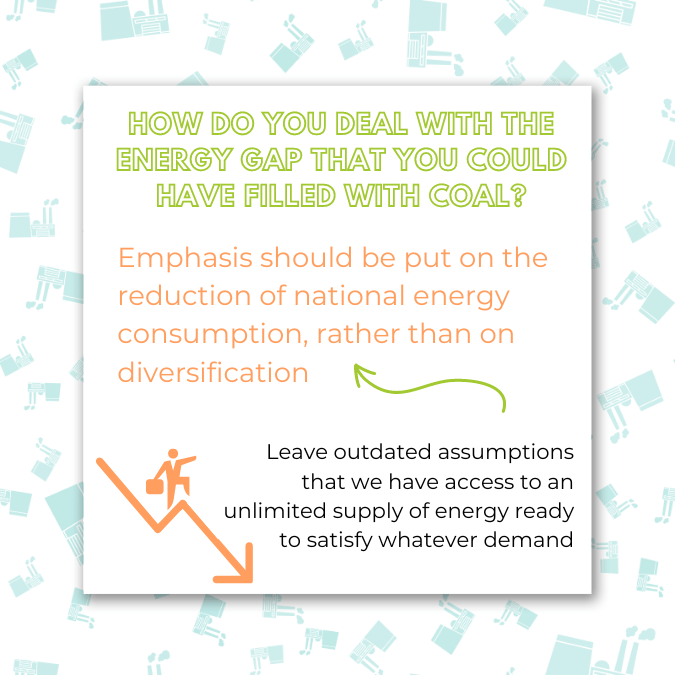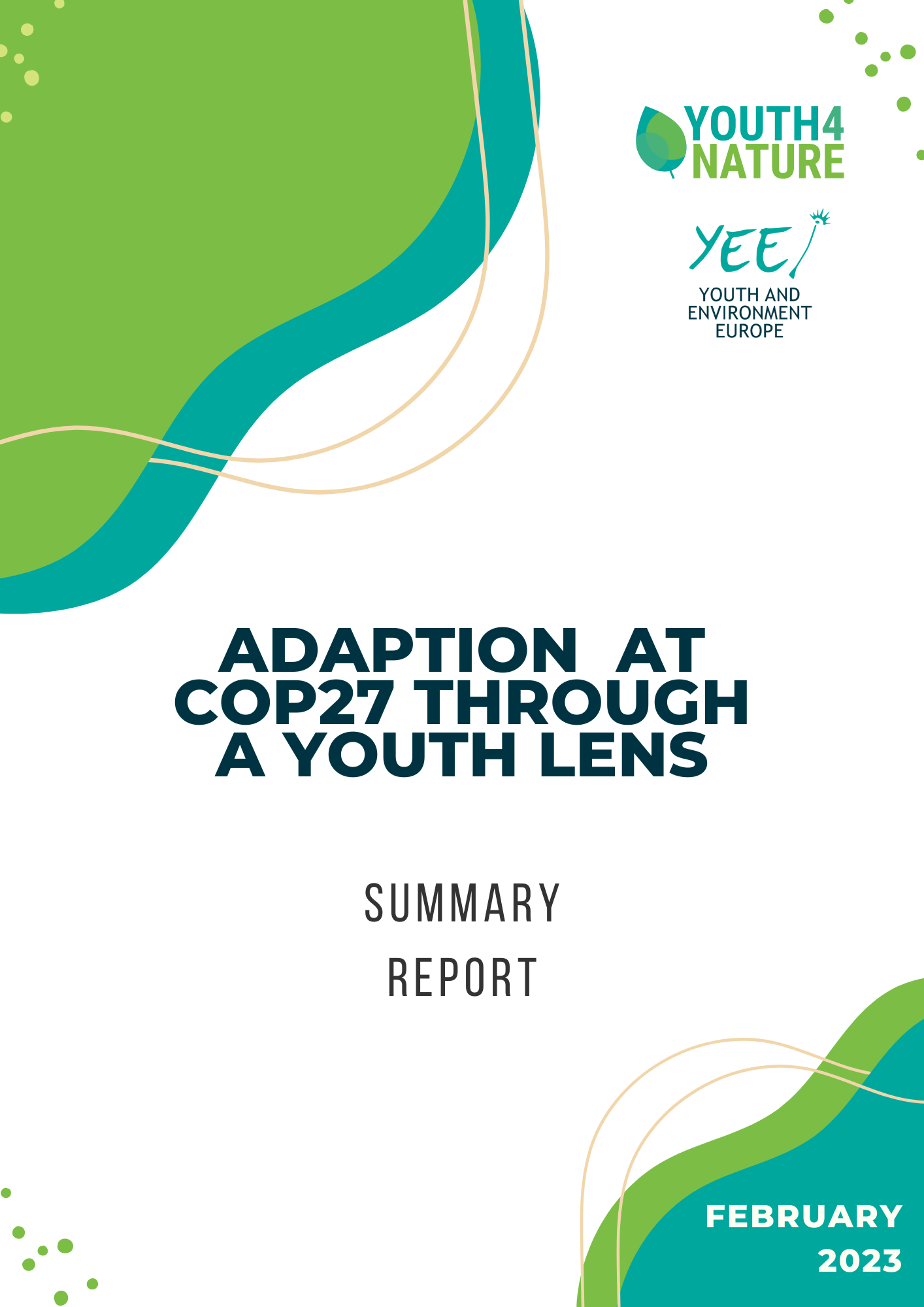We need to find a reason to grow
Mihai Oancea, a young Romanian from a traditional Roma community, is a founder of the youth NGO, ROMA T.E.A.M. Association. They offer mentorship programs and screening activities for vulnerable communities, with a focus on empowering young people. Mihai’s vision is to create community centers for education and mental health, and he believes that Roma people should be involved in different contexts to fight against racism and make the community more inclusive.


Tell us a bit about yourself. Who’s Mihai?
My name is Oancea Mihai. I’m from Romania. I’m 27 years old, and I’m currently living in Bucharest, but I’m from Argeș County, from a traditional Roma community.
What are the projects you are working on?
I have a youth NGO called ROMA T.E.A.M. Association, but I’m also working for another NGO. I work for the Roma Center for Health Policies-Sastipen in Bucharest. I engage with a lot of Roma and non-Roma communities in screening activities of people from rural and urban areas, but mainly focusing on vulnerable situations. Us, as the young people working there, we found out that the young generation there is not active at all within the communities.
After visiting a lot of different communities, we concluded that we should help. We started a mentorship program in some of the communities that we have been involved in. And after the program was set up, we wanted to carry on. We decided to open a youth NGO, a Roma youth NGO, but not helping just Roma people, because were going for diversity.
We tried to gather resources in order to attract young people. We are trying to grow the organisation into working at the grassroots level with the people. So we have so many plans, but we will take it step by step.
How are you attracting young people to join you?
All of us come from rural communities. We are Roma people. We are also non-Roma people. We have been there. We know how it is. We know how to handle difficult situations and how to attract people. Because we have been in their situation. This is the key that we are using in order to work with them.
What about your personal journey? How did you get to where you are?
One day, someone from an organisation called me, asking me to deliver some packages for the kids at the Christmas market. And I knew the organisation was working with people with fewer opportunities in vulnerable situations. And I’ve been there as well.
I knew how the people were feeling. I asked the project coordinator if I could help out with something or if I could do something for the children.
I wanted to be a volunteer. I started to volunteer with the children. I was doing their homework with them. I was providing them with food to eat and then cleaning after them. And they started to call me a teacher. It was a big step for me, wow, they are calling me a teacher.
It was a very nice opportunity to try to get more involved in other people’s lives, especially with the young people, Roma and non-Roma people.
When I moved to Bucharest for university I knew someone who, at the time, was working for the first Roma organisation from Bucharest. I became a volunteer there and I participated in their projects. I met a lot of people.
Then I visited a youth NGO and I saw something different from what I had done before. I wanted to get more involved. I got involved with the Romanian Roma Youth Civic Union, a nationally known organisation, where I continued to work for young people, especially for Roma youth. For a few years, I organised activities such as youth forum rights and human rights activities.
I enrolled in the postgraduate program here in Bucharest, and I started to work for the Roma Centre for Health Policies-Sastipen. Here we started creating new opportunities and meeting new people. That is how I ended up opening a youth NGO for Roma people and continuing working for the old NGO in the health sector.
What is your vision?
When we started the NGO, we felt that we needed to do a different kind of work, that was more grassroots level. We are working at the grassroots level and trying to empower young people, as well as working with parents from rural communities.
“What we aim to do is try to change the mentality of the people, to show them new opportunities, to empower them to shape their own future, knowing they can decide what to do with their future and that they have a right to it. “
We go to the rural communities, we work with the children and as they grow up, they know that they will have opportunities. Their teachers and parents will also be involved in their personal development, this is the key.
What is your strategy?
We would like to have a community centre, not just one, but one for each area that we work in. That is a big plan for the future.
For the moment, we want to focus on small communities and grow step by step. We are involving the local authorities in the young people’s education and we try to work with the teachers because they are key in supporting students with their studies and letting them know that it is important to believe in themselves. We also want to start focusing more on mental health. We are part of the French Embassy and Youth French Council from Romania where we applied for a project focusing on mental health.
We chose a high school from Bucharest, to have a pilot project. It is very important to start talking about mental health in these communities, as Roma people experience a lot of discrimination and this is one part of the puzzle to combat it. Focusing on mental health is very important in order for the students to be motivated to go to school, to try to and see other things in their life.
If you could send a message to the young people out there, what would it be?
I would have wanted to know about the opportunities that were out there back in my childhood. I didn’t know that I had the opportunity to get educated about my financial situation, personal development and other things. The thing is that we need to find a reason to grow. We need to find a reason to go to school and we need to find a reason to see life with new eyes.
And we need to search for that, not just stay in one place waiting for it. Try to look for the things that you need in your life. Try to communicate more with your parents, with your teacher, and with yourself, it’s very important.
Try to work with yourself. Get to know yourself. Try to see what are the challenges in your life in order to challenge them.
Transform yourself. Go for the opportunities.
The Erasmus Plus project is helping a lot. This is an opportunity to show young people with fewer opportunities other perspectives of life, to meet new people, experience new cultures, and share theirs.
“When I first went to an Erasmus Plus project, I met Roma people from Greece. I’m Roma from Romania. We spoke the Romani language. It was like a revelation. Look what happened. Look how nice it is.”
Erasmus Plus projects are also an important opportunity to involve people and try to insert themselves in new contexts. It gives them the opportunity to consider that they can be a teacher, they can be a doctor, they can become a lawyer.
As a Roma community, we have experienced a lot of discrimination, racism, and slavery, and we have been through the holocaust. I want to be there when people learn about that. I want to see the young generation spreading the information in order to fight against racism and make the community more inclusive so that people can understand us better. We are not different. We have been there in war, we have been there at the dawn of society. We have a culture and we have perspectives.
Other interviews

We need to make climate education a reality | Emilia Rygielska
Emilia is a 17 years-old activist and climate educator from Poland. In the following article, she talks about her experience with teaching kids about the climate crisis and why she thinks that politicians stand in the way of change.

Make at least one small eco change in your life | Ola Czajkowska
Social media on environmental issues can sometimes be the only source of knowledge for young Poles. Ola Czajkowska, a 26-year-old resident of Warsaw, has taken matters into her own hands.
Introducing Mihai | Showcasing the Unheard
https://yeenet.eu/wp-content/uploads/2023/10/mihai.png 675 675 YEE https://yeenet.eu/wp-content/uploads/2018/11/logo-yee-728x1030.png YEE2023-04-05 13:08:542023-10-05 13:14:02Introducing Mihai | Showcasing the UnheardIs the Global Biodiversity Framework enough?
Discussing the outcomes of COP15 and the next steps

Written by
Heather Needham
Sophia Ullrich
Contents
Visual summary












Share this article
The Biodiversity Crisis
It is 2023 and we are in the midst of the 6th mass extinction. Unlike the five extinction events before, this one is primarily caused by human activity and the unsustainable use of land, water, and energy. According to the latest Living Planet Report, published in 2022, there has been an average 69% decline in monitored global wildlife populations between 1970 and 2018.
Due to the interlinked nature of the climate and biodiversity crises, rising temperatures are already causing mass mortality events, causing entire species to go extinct. Climate change is expected to replace land use change as the main driver for biodiversity loss if the 1.5-degree target will not be met, underlining the urgency of bold action on both crises.
The 15th Conference of the Parties (COP) of the Convention on Biological Diversity that was held in December 2022 was a crucial moment for 196 countries to come to an ambitious agreement that would put us on the path to come to “peace with nature“. With the stakes as high as they are today and none of the Aichi targets of 2010 being met, the hopes for a complementary goal to net zero by 2050 – net-positive biodiversity by 2030 – were high, together with the delivery of strong targets to set us on the path to a safe future for humanity.
What is the Convention on Biological Diversity?
In 1992, a historic international legal instrument (known as a treaty) for the conservation and sustainable use of biodiversity, and equitable sharing of genetic resources was agreed in Rio de Janeiro, Brazil. Today, 196 countries have ratified the treaty, known as the Convention of Biological Diversity (that’s nearly every country on the planet!).
The Parties of the CBD, meet regularly every two years to set commitments and global targets. In 2010, the countries united to set the twenty Aichi Biodiversity Targets (under the CBD Strategy Plan for Biodiversity 2011-2020) in order to make radical changes to protect and prevent irreversible biodiversity loss across the world. A decade later, on the expiration date, disappointingly, in a UN report, it was found that not a single one of the targets had been met.
With biodiversity declining rapidly over the last decade, an agreement and agenda for 2030 and 2050 was urgent. Two years delayed (December 2022), the members of the CBD met for COP15 which was held in Montreal, Canada with the goal to finalise and agree to targets for protecting and enhancing nature for 2030 and 2050.
Global Biodiversity Framework
The conference concluded with an international agreement that set new goals and targets, recognised as the Kunming-Montreal Biodiversity Framework (GBF). The GBF includes four overarching goals and 23 targets to achieve by 2030.
Kunming-Montreal Global Biodiversity Framework: 23 targets
| Target | Description |
| 1 | Effective management of land- and sea-use change, loss of highly important biodiverse areas close to zero by 2030 |
| 2 | Effective restoration of 30% of degraded ecosystems by 2030 |
| 3 | Effective conservation and management of 30% of land and 30% of oceans by 2030 |
| 4 | Halt human-induced extinctions and maintain and restore genetic diversity |
| 5 | Sustainable use, harvesting and trade of wild species |
| 6 | Mitigate or eliminate the impacts of invasive alien species, reduce the rates of establishment of invasive species by 50% by 2030 |
| 7 | Reduce pollution risks and impacts from all sources by 2030, reduce the overall risk from pesticides by half |
| 8 | Minimise the impacts of climate change and ocean acidification on biodiversity |
| 9 | Ensure sustainable use and management of wild species, while protecting customary use by Indigenous peoples |
| 10 | Sustainable management of areas under agriculture, aquaculture, fisheries and forestry |
| 11 | Restore and enhance ecosystem function through nature-based solutions and ecosystem-based approaches |
| 12 | Increase the area and quality of urban green and blue spaces |
| 13 | Fair and equitable sharing of the benefits arising from the use of genetic resources |
| 14 | Integration of biodiversity into policies and development across all sectors |
| 15 | Enable businesses to monitor, assess and disclose their impacts on biodiversity |
| 16 | Encourage sustainable consumption, including by reducing food waste by half by 2030 |
| 17 | Strengthen capacity for biosafety measures and ensure benefits-sharing from biotechnology |
| 18 | Phase out or reform harmful subsidies in a just way, reducing them by $500bn by 2030 |
| 19 | Substantially increase financial resources, mobilise $200bn per year by 2030 from all sources, including $30bn from developed to developing countries |
| 20 | Strengthen capacity-building and technology transfer |
| 21 | Integrated and participatory management, including the use of traditional knowledge |
| 22 | Equitable representation and participation of Indigenous peoples and local communities |
| 23 | Ensure gender equality in the implementation of the framework |
30 by 30
One of the targets that had been on the agenda far in advance is target 3. Pushed for by the High Ambition coalition (an intergovernmental group of more than 100 countries), the target calls for 30% of the earth’s land and sea to be effectively conserved and managed by 2030. This should be achieved through the establishment of protected areas (PAs) and other area-based conservation measures (OECMs).
On a European level, the most important categories of PAs are the Natura 2000 network established through the Birds and Habitats Directives, the Emerald network and UNESCO Biosphere reserves. Target 3 acts as the replacement of Aichi target 11, which aimed for the protection of at least 17 percent of terrestrial and inland water, and 10 percent of coastal and marine areas. While that target was not met on a global level, it was partially successful in numbers, the number of terrestrial PAs increasing from 10% to 15% and from 3% to around 7% in marine areas, as reported in the Global Biodiversity Outlook 5.
However, concerns regarding the actual quality of the PAs were high, as many lack connectivity, don’t always safeguard the most important areas for biodiversity and are not equitably and effectively managed. The quantity vs. quality debate is continuing now with the 30 x 30 target, demanding the GBF to emphasise the quality of PAs and OECMs to accompany the 30% target.
In connection to target 22, which calls for equitable representation and participation of indigenous peoples and communities (IPLCs), there is serious concern about the 30 by 30 target on indigenous rights, as it fails to recognise indigenous rights as a separate category of PAs. In a joint statement, a group of major human rights organisations such as Amnesty International claimed that the target “will devastate the lives of Indigenous Peoples and will be hugely destructive for the livelihoods of other subsistence land-users, while diverting attention away from the real drivers of biodiversity and climate collapse”.
This so-called “fortress conservation” describes conservation initiatives that focus on nature in the very narrow sense and don’t take traditional territories and livelihoods of IPLCs into account, not acknowledging traditional knowledge. Studies have found that areas managed by indigenous communities contribute equally as much to global biodiversity conservation as state-governed areas and other governance types.
Increase finance for biodiversity
Target 19 of the Framework aims to mobilise at least US $200 billion per year in international biodiversity funds and raise international financial flows from developed to developing countries to at least US $20 billion per year by 2025, and to at least US $30 billion per year by 2030.
Directing funds towards developing countries is important since they are often home to the largest share of the world’s biodiversity and face significant economic challenges that can make it difficult to invest in biodiversity conservation and restoration efforts. However, according to a report from the Nature Conservancy, at least $700 billion (again, instead of US $200 billion) a year is needed to fund activities that benefit nature and resultantly, reverse global biodiversity loss by 2030. Therefore, there is a shortfall in international biodiversity funding and concerns about how the gap in biodiversity finance will be achieved.
In addition at the Conference, it was agreed that the Convention through the Global Environment Facility (GEF) will set up a Special Trust Fund (known as the GBF Fund) to act as a financial mechanism for the implementation of GBF. However, the GBF is seen as a shortfall since the Parties failed to create a dedicated international biodiversity fund separate from the existing GEF fund. The GEF is under-resourced and also addresses other global issues such as climate change (it funds UNFCCC and the Paris Agreement). Moreover, there are issues accessing the GEF funds and bias of funding towards countries that have the capacity to submit proposals.
Reduce environmentally damaging subsidies
Target 18 of the Framework aims to phase out or reform harmful subsidies for biodiversity and reduce them by at least USD 500 billion per year by 2030. A study this year found that global governments spend at least $1.8 trillion a year (equivalent to 2% of the global GBP) on subsidies that harm the environment. Fossil fuel, agriculture and water industries receive 80% of these EHS per year. A similar target for reforming subsidies was part of the Aichi targets which wasn’t achieved. Governments failed to act on subsidies and there is concern that Target 18 of the GBF might not be reached. The loss of biodiversity from perverse subsidies undermines and works against the goals of the CBD.
There is a need to redirect a significant proportion of the subsidies to support policies that are beneficial for nature, rather than “financing our own extinction”. Redirecting and repurposing subsidies can make an important contribution to finding the US $700 billion per year in biodiversity funding needed. In the EU Biodiversity Strategy for 2030, the European Council pledged to phase out EHS and reform subsidies that have negative impacts on biodiversity. Moreover, the EU is working to reform the Common Agricultural Policy, which has historically supported intensive farming that can contribute to biodiversity loss, to promote more sustainable farming and reduce the use of pesticides and fertilisers. In addition, the EU’s Common Fisheries Policy includes measures to promote sustainable fisheries management and reduce the environmental impacts of fishing activities.
Youth NGOs and their role in nature conservation
While The Global Biodiversity Framework has increased ambitions compared to its predecessor, is without a doubt an imperfect solution. Calls for higher numbers in funding, changes in the funding structures as well as concerns about indigenous rights and the quality of Protected Areas are credible and are just examples of weak points of the GBF.
To save the trust in and credibility of the agreement, the actual implementation of the targets in the coming 2 years (until the next CBD COP) will be crucial. If done right, the agreement does have the potential to make a difference in biodiversity conservation on a global scale. However, taking into account the lack of quantifiable measures that make it possible to hold countries and governments accountable, the role of actors of the civil society and ultimately Youth is undeniable and should act as a motivation to push for the implementation of the agreement.
Prior to the Conference, the Global Youth Biodiversity Network (GYBN) had expressed strong concern that judging from the draft agreement, the GBF would lead to another decade of „more of the same“, describing a lot of the proposals as „false solutions“. Following the activities of Global youth networks and NGOs such as the GYBN is the first easy step you can take to step up for global biodiversity conservation. Holding governments accountable is up to us, especially considering the fact that the agreed targets are not legally binding for the signing parties. That is why getting involved on a national level is just as important, which can easily be done by contacting the MP of the department for environment, raising questions, concerns and thoughts. Youth are raising awareness for the issues concerning nature conservation and climate change by getting involved in International Youth Boards and organisations and making sure that their voices are heard.
More To Explore
Is the Global Biodiversity Framework enough?
https://yeenet.eu/wp-content/uploads/2023/03/1-2.png 540 540 YEE https://yeenet.eu/wp-content/uploads/2018/11/logo-yee-728x1030.png YEE2023-03-30 13:13:382024-09-30 16:44:39Is the Global Biodiversity Framework enough?Germany has a toxic boyfriend
The relation between the country and coal in the context of the climate and energy crises.

How did we end up with an energy crisis in Europe?
The consequences of the sudden cut in oil production caused by the covid-19 pandemic, together with the sanctions (and the related retaliatory policies) that followed the Russian invasion in Ukraine, stifled the supply of fossil fuels to Europe. With gas, coal and oil becoming increasingly harder to source, their price has skyrocketed, thus triggering an energy crisis.
Effect of the Energy crisis in Germany
Of all the countries in Europe, Germany is particularly vulnerable to this disruption in the global fossil fuel supply chain. On the one hand, the country has the highest demand for electricity in Europe. On the other, most of this demand is met by burning imported gas, coal and oil (i.e., those same commodities whose price has gone through the roof recently). To make things worse, until recently the country’s primary supplier was – you guessed it – Russia. I don’t want to bother you too much with the numbers, but in case you are interested here are two detailed sources to learn more about the German Energy Mix and its Fossil Fuels Supply chain.
As of Spring 2022, government officials find themselves in a tricky position. They need to come up with a way to meet the biggest demand for energy in the continent, or else the country’s economy will collapse, but imported fossil fuels are increasingly inaccessible and expensive. To respond to these challenges, a wide set of policies are implemented with the aim to reduce Germany’s dependence on international markets. Some actively foster the energy transition, by boosting investment in renewables and promoting consumer and producer sobriety. Others, however, go in the opposite direction.
Breaking a nine year trend, since 2021 the share of coal used in the country’s energy mix has started to grow again. While in 2019 the government had established a plan to completely phase out coal by 2038, now the priorities seem to have changed. In an effort to replace some of the energy previously produced with Russian gas and oil, it has been decided that 20 coal-burning plants that were supposed to be shut down by 2023 (according to the original timeline) will instead continue operations this year. The inability to source gas from international markets has also been used to provide political legitimacy to the decision to go through with the expansion of the Garzweiler II brown coal (aka lignite) mine, which now also includes the soil under the recently demolished Lützerath.
Not everyone agreed with the idea of destroying this small town in the middle of the Rehin region. Since 2020, thousands of activists had been occupying the area to prevent the expansion of the mine. The argument was simple: if the fuel under Lützerath is burnt, its emissions will make it hard for Germany to meet the emission reduction targets it agreed to in 2015. This claim was backed by the German Institute for Economic Research. In the end, the pro-coal faction won and in late January the village was evacuated, allowing the expansion to start.
Can coal be considered a temporary solution to the energy crisis?
If what we are looking for is an immediate way to provide more energy to the system, increasing coal consumption seems to be an effective and easily achievable — albeit a bit short sighted — solution to the energy crisis. Firstly, internationally sourced hard coal offers a cheaper substitute to the more scarce and more expensive gas. Secondly, lignite is the only fuel that can still be domestically sourced from the country’s active mines. As such, it is a more reliable, less volatile source of energy, whose use contributes to the temporary strengthening of the country’s energy sovereignty. Finally, the infrastructure to turn coal into energy is already there, meaning that increasing capacity requires smaller investments and less time.
Nonetheless, all this comes at a great environmental and social cost. At the global level, coal is the deadliest source of energy. Throughout the world, for every terawatt-hour of electricity produced using hard coal 25 people lose their lives. The figure rises to 32 deaths when we consider lignite (which, as a reminder, is the type of coal that is mined in Germany). Looking more specifically at the case of Germany, coal is responsible for up to 2260 preventable deaths. If you want to learn more about how deadly are other sources of energy, you can check out this interesting visualization made by Statista. The reason behind this macabre first place is pretty straightforward : coal (and especially lignite) releases a high quantity of toxic pollutants in the atmosphere. Talking about first places, the burning of coal is also the single largest contributor to anthropogenic climate change, emitting more CO2 per gigawatt-hour produced than any other fossil fuel. Consequently, if coal is not eliminated from the country’s energy mix fast enough, meeting the emission reduction targets agreed upon in Paris becomes basically impossible, as we were reminded by the “1.5 degrees means Lützerath stays” banner outside the entrance of the occupied town.
The example of Lützerath also points at another important limitation of coal. Lignite mining takes space and in doing so, it destroys both social and natural ecosystems. Since the end of WW2 around 300 cities have been destroyed to make space for extraction operations, with that more than 120 thousand people have been eradicated from their local communities and relocated somewhere else. With that, pieces of cultural heritage have also been demolished, such as the church of St. Lambertus in Immerath. Aside from impacting human settlements, land mining also radically changes the landscapes of the areas in which it is performed, thus destroying the habitat needed for the local flora and fauna to survive and increasing the risk of loss of biodiversity.
Ok, but what do we make of this – maybe a bit disproportionate – pros and cons analysis? In light of what I just said, I would argue that increasing coal use cannot be an answer to the crisis. We know that producing electricity by burning this fuel implies a high environmental and social toll that is hard to justify. Because of this, the government has decided to phase out coal completely by 2038. At the same time, however, to this day coal is still a pillar of the German economy. In 2021, it supplied 30% of the national demand for electricity and, in 2018, it provided almost 40 thousand jobs (this last piece of data is a bit old, but given the trends we described before I would expect up to date figures to still be a sizable number). Consequently, unwinding this deep integration without causing a socio-economic crisis takes time – as shown by the fact that the final target date set by the government is in 15 years – and erasing the progress done in the last couple of years makes the process even longer. This means more pollution, more land use and more preventable deaths. On top of this, the country really does not have the space of maneuver to delay this process any further than it already has if it wants to meet the emission reduction targets it agreed to in 2015.
How do you deal with the energy gap that you could have otherwise filled with coal?
While renewables are of course an option, I would suggest more emphasis should be put on the reduction of the national energy consumption, rather than on diversification. The energy and environmental crises are showing us that it is now anachronistic to assume we have access to an unlimited supply of energy ready to satisfy whatever demand we might have. Hence, it is time that we come to terms with this reality and start building our production and consumption patterns based on the amount of energy that is sustainable to consume. I understand that this is a radical change, but, whether one likes it or not, we are entering an age of limits. If we adapt to it gradually, we will have to sacrifice a bit more at first, but we will be better fit for it in the long run. If we ignore what is happening, the change in the way we live will be more traumatic and potentially dangerous.
Of course, this line of reasoning stretches further than the borders of Germany and, mutatis mutandis, applies to every policy solution that is supposed to tackle the environmental and energy crises.
More articles
The war in Ukraine has highlighted the significance of energy policy as a major power issue. It is an opportunity to break
How is our generation responding to the challenges posed by the energy crisis and the imperative for a green transition? This thought-provoking
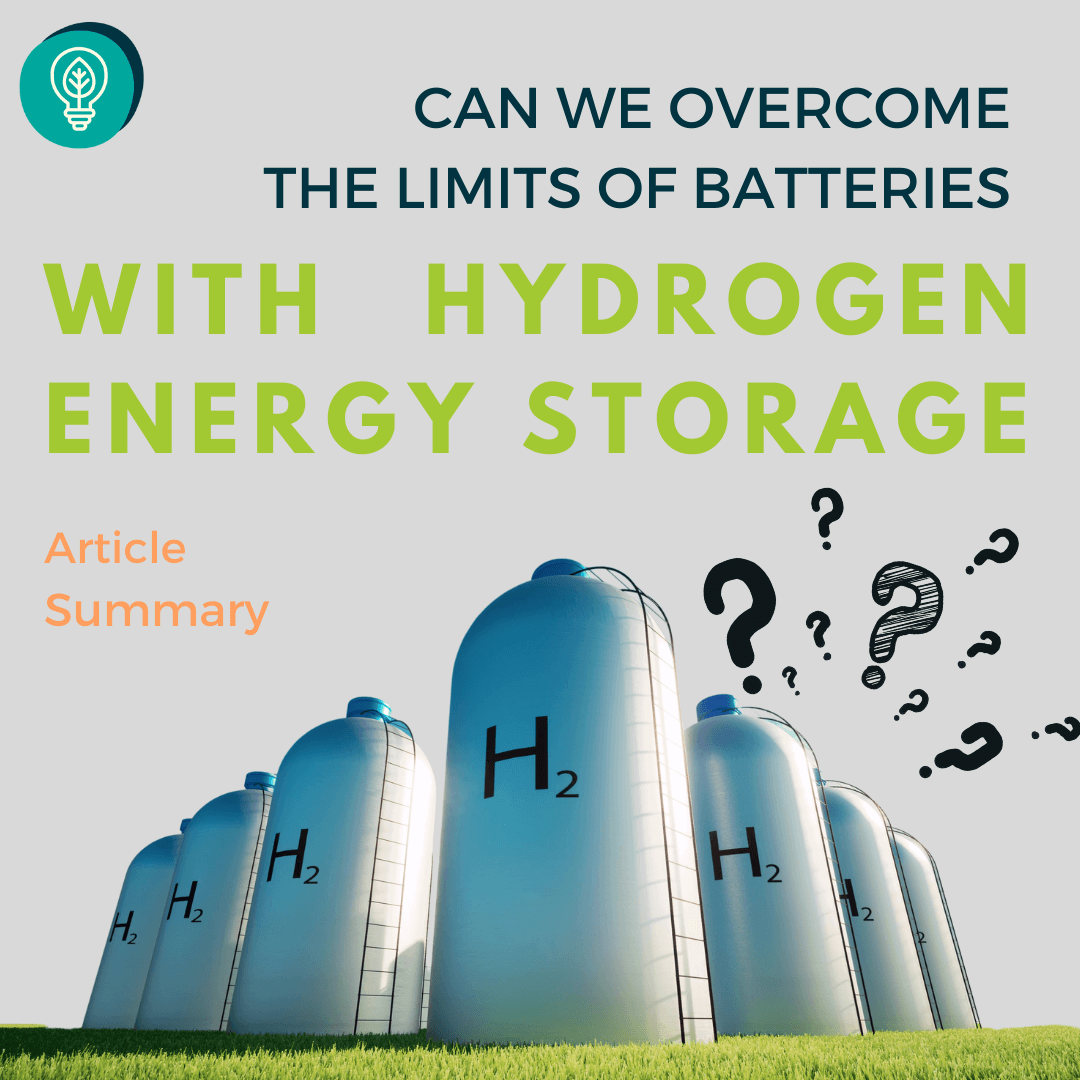
In this article, we will delve into the exciting world of hydrogen as a potential solution for energy storage, aiming to overcome

Learn about the positive and negative outcomes of the liberalisation process, and how energy communities could play a major role in the
More To Explore
Germany has a toxic boyfriend
https://yeenet.eu/wp-content/uploads/2023/03/IG.png 675 675 YEE https://yeenet.eu/wp-content/uploads/2018/11/logo-yee-728x1030.png YEE2023-03-27 16:01:412023-06-23 09:18:20Germany has a toxic boyfriend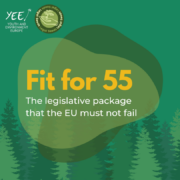
Written by
Contents
Visual summary










Learn more about the project
Share this article
What is Fit For 55?
The European Green Deal significantly raises the EU’s climate ambition to deliver on its multilateral commitments under the Paris Agreement (2015) and put it on a path toward climate neutrality. The FF55 is a set of twelve proposals presented by the European Commission on 14th July 2021 that aims to revise and update EU climate policies with the objective to make a legal obligation for all the EU countries to reduce greenhouse gasses (GHG) to 55% compared to 1990 by 2030. It implements and meets the longer-term Green Deal, by aligning with the EU objective of reaching climate neutrality by 2050.
The aim is to guarantee a just and socially fair transition and strengthen innovation and competitiveness of EU industry while ensuring a level playing field vis-à-vis third country economic operators. Furthermore, it is used as a tool for the EU to lead the way in the global fight against climate change.
The Fit for 55 package’s proposals were presented and discussed at a technical level within the Council’s working parties responsible for the policy area concerned before they landed on the table of EU member states. Discussions are held to prepare the ground for an agreement on the proposals among the 27 member states. EU ministers, in various Council configurations, then exchanged views and seeked an agreement on a common position on the proposals. This forms the basis on which the presidency of the Council then engaged with the European Parliament in negotiations to find a common agreement in view of the final adoption of the legislative acts.
The Fit for 55 package was submitted to the Council in July 2021 and it is being discussed across several policy areas, such as environment, energy, transport, and economic and financial affairs. Concretely, the FF55 is composed of different rules regulating climate-related sectors and includes a high variety of sectors, among which the: Renewable Energy Directive (RED); The Emission Trading System (ETS); The Effort Sharing Regulation (ESR); The Land Use, Land Use Change, and Forestry Regulation (LULUCF).
2019, 2020 & 2021 – How do we achieve climate neutrality?
The Fit for 55 takes its sources in 2019 when the EU leaders endorsed the 2050 Climate neutrality objective. Poland was the only one to express reservations on the subject. Following this resolution, in October 2020 the EU leaders discussed the EU’s Climate ambition for 2030 and the Council adopted conclusions on the EU biodiversity strategy for 2030.
Things accelerated in April 2021 when the Council and the Parliament reached a provisional agreement of reducing greenhouse gasses (GHG) to 55% compared to 1990 by 2030. On 20 July 2021, EU environment ministers discussed FF55 during an informal meeting, and from this date, the official discussion started.
The first formal minister debate took place on October 6 and was focused on the impact of the proposals on citizens, emissions trading to buildings, and road transports.
For the last meeting of the year 2021, the environment Council took note of a progress report prepared by the Slovenian presidency and held a policy debate on five of the files in FF55 which are:
- revision of the greenhouse gas emission allowance trading scheme (EU ETS)
- revision of the regulation on binding annual greenhouse gas emission reductions by member states (effort sharing regulation)
- revision of the regulation on greenhouse gas emissions and removals from land use, land use change and forestry (LULUCF)
- revision of rules for CO2 emission performance standards for new cars and vans
- regulation establishing a social climate fund
*Infographic – Fit for 55: how the EU will turn climate goals into law
2022 – securing the energy supply
On 24 February 2022, the Russian invasion of Ukraine started. Since then, the EU has been facing the challenge of security of energy supply due to its dependency on Russian gas, and as 45% of natural gas consumed by the EU comes from Russia, it was quickly necessary to find alternative sources and therefore, by force of circumstance, to review the FF55 energy plan.
Thus, within the Parliament, ongoing discussions target the ways in which these rules can be amended, changed, and updated to meet the climate policy objectives. The European Commission presented on March 8 the idea of coming up with a new project which aims at phasing out Russian fossil fuels and becoming more autonomous and independent regarding its energy supply and security. The plan was well received by EU leaders, who signed the Versailles declaration. They all agreed on the necessity to make the EU independent from Russian energy imports as soon as possible. On May 18, the Commission presented the REPowerEU plan, and a week after the EU Energy Platform Task Force was established to secure alternative supplies.
On 29 June 2022, the Council of the EU adopted a common position on the package presented in July 2021 by the Commission. A general approach under the French Presidency was agreed on, which differs in significant ways from the European Parliament’s Committee for Industry, Research, and Energy (ITRE) report.
More precisely, Member States adopted a common approach to the EU emissions trading system (EU ETS), effort-sharing between member states in non-ETS sectors (ESR), emissions and removals from land use, land-use change and forestry (LULUCF), the creation of a social climate fund (SCF) and new CO2 emission performance standards for cars and vans.
The Council supports a binding renewable energy sources (RES)target of only 40 % by 2030, reflecting the Commission’s original proposal (July 2021). The general approach offers Member States the flexibility to choose between a 13% reduction in GHG intensity or a 29 % share of RES in the final energy consumption in the transport sector by 2030. The general approach proposes lower sub-targets for mainstreaming RES in heating and cooling (+0.8% annually until 2026 and +1.1 % thereafter) and industry (+1.1% annually), but also requires that 35 % of the hydrogen used in the industry should come from RFNBOs by 2030, rising to 50 % by 2035.
This common position is called “general approaches”.
The year 2022 ended up with endless negotiations regarding nuclear power. The socialists and greens support banning atomic power, but some countries, more nuclear-dependent such as France, are opposing the above positions towards atomic energy. Finally, on July 6, the Parliament voted to record nuclear power as renewable energy. The chapter on renewable energies of FF55 is therefore greatly impacted since the threshold to be met will now include not only solar and wind energy but also renewable nuclear and gas.
2023 – planning ahead
Even though 2023 just started 3 months ago, the discussion around the possibility of setting national sustainable aviation fuel (SAF) is still in process. Indeed the aviation industry is one of the main parts of Fit For 55. Under this regulation, all planes departing from an EU airport will have to refuel as they become available with sustainable aviation fuel (CAD) — low-carbon alternatives to kerosene made from advanced biofuels and hydrogen-derived green synthetic fuels.
The European Parliament and the Council do not agree on the percentage of CAD to be imposed — the Parliament wants 85% by 2050, while the Council sticks to the 63% proposed by the Commission — and on the matters first to be designated as “sustainable”.
The inclusion of nuclear as a potential energy source to create synthetic fuels was the red line for Socialist (S&D) and Green (Greens/EFA) MEPs.
FuelEU Maritime, the sibling of ReFuelEU Aviation, will also be negotiated in 2023.
Unlike the aviation fuel law, FuelEU does not mandate the type of fuel that must be used in ships. Rather, it sets increasingly strict carbon intensity limits that must be respected.
However, green-minded legislators are concerned that giving the shipping industry carte blanche will see them choose the cheapest rather than the greenest option to meet the targets. Specifically, the option to fuel ships with liquefied natural gas – a fossil fuel – up to 2030 has proven controversial.
Finally, concerning the automotive sector, new thermal engine cars will be banned from sale by 2035. However, the lack of charging stations creates a significant problem for the development of electric cars.
Both the private sector and national governments are working to increase the availability of charging points. In Brussels, the issue is addressed through the Alternative Fuels Infrastructure Regulation (AFIR).
AFIR sets out requirements for the number of charging stations along the EU’s main transport corridors and aims to make it easier to pay for charging, particularly when crossing into another EU country.
Access to Justice in the FF55
Other than being crucial that MEPs find fast, common agreements on these, it is also likely crucial that Member States (MSs) implement and enforce the package. Once adopted by the EU, the package will be in the hands of MSs, which have the responsibility to implement the updates.
The Aarhus Convention, signed in 1998, sets three important pillars —access to information, public participation, and access to justice — which are the cornerstones of environmental and climate governance in Europe. As also parties of the Convention, EU member states and the EU itself have an obligation to implement all its pillars.
Among these pillars, ensuring that EU citizens and NGOs have the right of access to justice is essential to make sure that member states are held accountable in case of disrespect of environmental and climate objectives. Despite the fact that regulations have a direct effect on Member States’ laws, access to justice in environmental matters is still very limited. The right of access to justice has been therefore subject to strong advocacy work from EU environmental NGO. According to them, it is crucial to have a liability mechanism open to civil society for holding MSs accountable for any violation: the climate emergency does not allow delays in the implementation of measures.
With the massive work around the FF55, there is a concrete possibility to include access to justice provisions within EU climate rules and ensure the empowerment of civil society in challenging MSs when not complying with the agreed targets. As a matter of fact, there is neither democracy nor a green Europe without sound and coherent access to justice: the FF55 must not be the exception.
Finally, it is important to remember that FF55 is still open for updates, the negotiations are still in process so NGOs can and must put pressure on Member States to make this agreement sustainable and greener.
More articles

Rivers – anywhere you are in Europe, there must be a river not far from you. Ancient Greeks would marvel at rivers
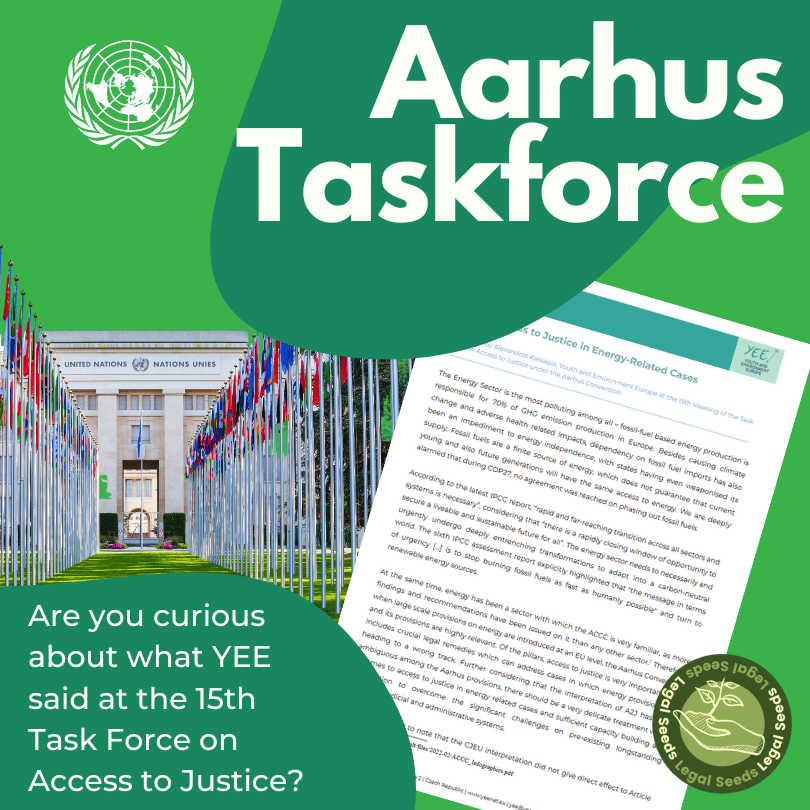
The Environmental Law Team of YEE actively participated in the 15th Task Force on Access to Justice in Geneva, sharing valuable insights.

The discussion within the EU around the Fit For 55 legislative package is at the core of the EU’s current action on
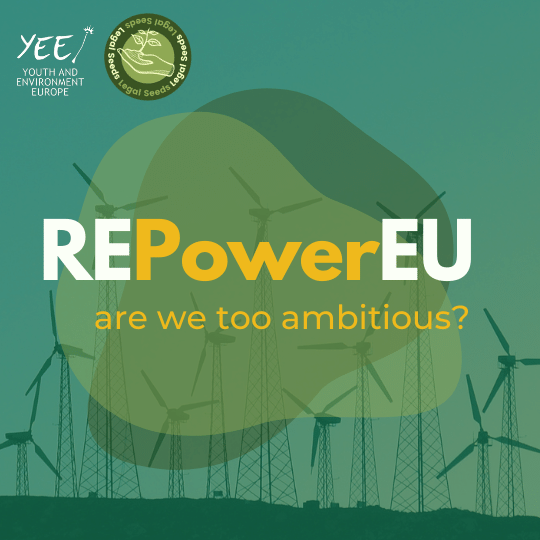
If exiting from the Russian fossil fuels, gas and coal import is a necessity, should it be then done at all costs?
More To Explore
Fit for 55: the legislative package that the EU must not fail
https://yeenet.eu/wp-content/uploads/2023/03/Ff55-Article-Cover1.png 810 810 YEE https://yeenet.eu/wp-content/uploads/2018/11/logo-yee-728x1030.png YEE2023-03-23 08:24:382023-03-31 15:01:18Fit for 55: the legislative package that the EU must not failClimate adaptation at COP27 through a youth lens
Youth and Environment Europe (YEE) and Youth4Nature (Y4N) are international youth-led organisations within the nature-climate nexus that strive to bring the voices of youth from across Europe (YEE) and across the globe (Y4N) to the forefront of environmental discussions and decision-making.
Building on this synergy and upon COP27 momentum – two weeks within the international agenda where all eyes focused on the climate negotiations – the two organisations met on the ground at Sharm el-Sheikh to share knowledge amongst youth peers globally on what adaptation is and how youth experience it, with an emphasis on amplifying diverse youth perspectives and environmental justice.
Points of the discussion
- What does climate adaptation mean for you?
- What have you heard about climate adaptation during COP27?
- What do you think are the gaps and how should we move forward?
- How would you link adaptation to climate justice?
- How can we achieve more involvement in climate negotations?
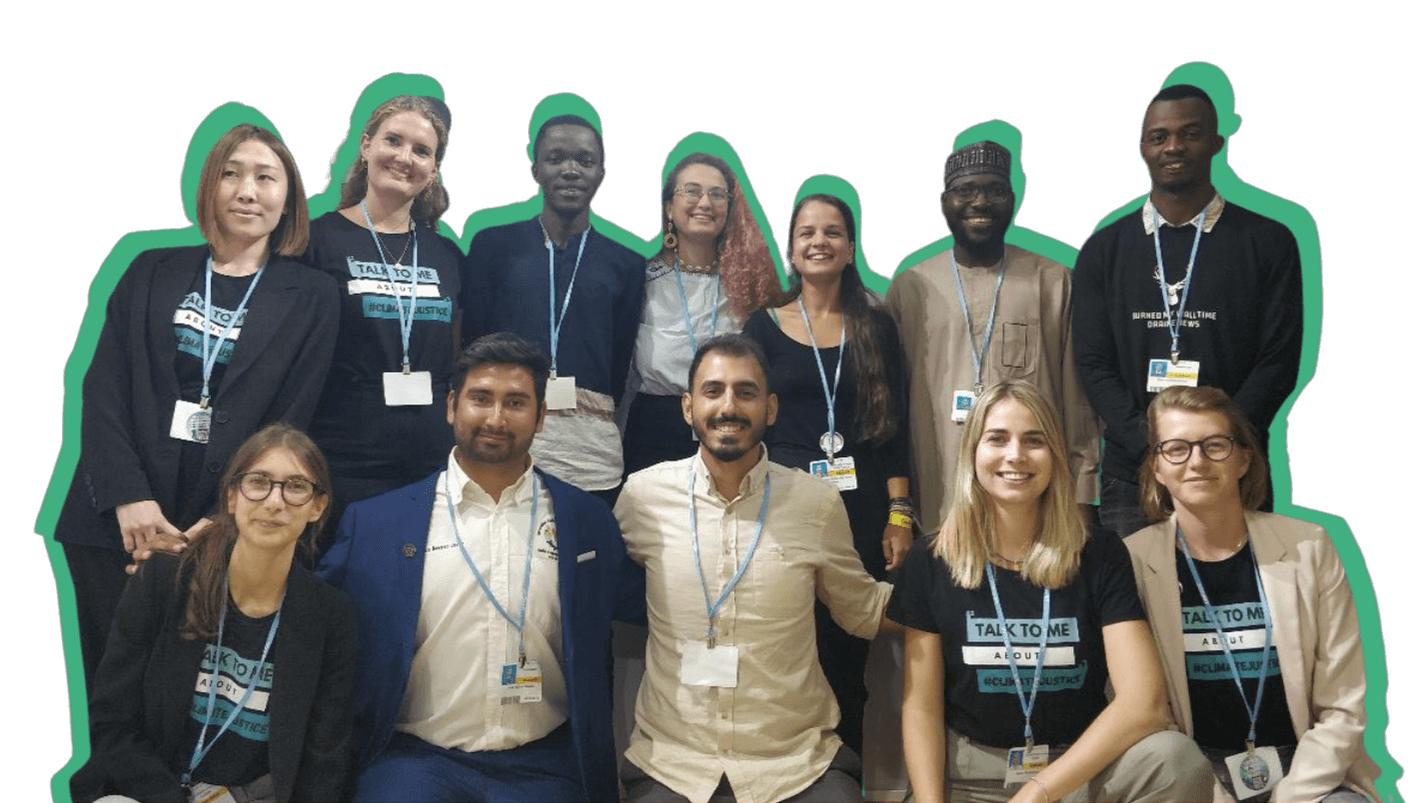





Adaption at COP27 through a youth lens | Report
https://yeenet.eu/wp-content/uploads/2023/03/YEEY4N-COP27-Adaptation-Report-Instagram-Post-Square.png 675 675 YEE https://yeenet.eu/wp-content/uploads/2018/11/logo-yee-728x1030.png YEE2023-03-15 11:26:272023-06-23 09:18:04Adaption at COP27 through a youth lens | ReportI am amazed about activists and their passion and drive
Disclaimer
The views and opinions expressed are those of the authors and do not necessarily reflect the official policy or position of YEE.
Kacper Lubiewski is a 19-year-old Israeli-Polish climate activist living in Berlin. He started his activism in 2019, joining the climate movement in the same year. He is also a member of a housing activist group. For him, activism means working towards change and making a difference. He encourages those interested in activism to research their chosen cause, find a community, and take care of themselves to avoid burnout.


Tell us a bit about yourself. Who’s Kacper?
My name is Kacper Lubiewski, I’m an Israeli-Polish activist. I have been based in Poland for the majority of my life, but for a year now I’ve been living in Berlin. I’m 19, and the majority of the activism that I used to do and that I’m still doing is climate activism. Since I moved to Berlin I also started being active in a housing activist group.
How did it all start for you?
It all started for me in 2019, so I have been active for four years now. I was 15 at the time and I attended a session of the European Youth Parliament (a great organisation by the way that I am recommending everyone to check out) and I met a lot of fantastic and motivated people there. This has really put me in a dilemma with what I am doing with my free time. I come from a village next to a small town in Poland called Opole and in my life I had this feeling that everything is sort of just omitting and getting by Opole and there’s nothing happening there.
And 2019 was the time of Greta Thunberg and climate school strikes. I wanted to be part of it. I saw great potential in the movement, that was just getting started but seemed like a cause that I wanted to help with. So yeah, that was definitely one part of it, just being surrounded by and seeing for the first time a lot of people who are active, passionate and dedicated.
I realised that’s an important cause and I’m not going to let another great big thing just not happen and that’s how I started a local group of Fridays for Future in Opole and then I started working with the national and international movement.
What does activism mean to you?
I think that activism can be understood very broadly, as in this day and age there are just so many ways to be an activist.
“You can be a cyber activist, a street activist, you can be a spokesperson, you can do graphics, you can do some other type of art you can use to support your voice.”
There are so many different areas but I think what binds it all is the drive for change. And I think that activists realise that there is something wrong in the status quo, be it climate policy or the situation of the queer community. And then they sense this need for change there and they work towards it.
I started being active in the climate movement just because I realised that this is purely a survival issue for the entire planet and the next generations on it. Sometimes it is a question of survival and knowing that this is the very last moment that we can do something about the climate catastrophe before we cross the tipping points.
What activities are you engaged in at the moment?
I’m still quite fresh in the housing movement. It’s only been a few months and I have dedicated most of my time to just learning and reading up on the issue. But when it comes to the climate movement, I’m proud of quite a few things. I feel like I and the rest of the people in my local group have effectively brought the climate movement to my city. We have organised dozens of different protests and we stayed vocal on a lot of issues. We have organised different types of protests, but I’m most proud of a very big march that we did there.
That was around the time of COP26 in Scotland. I’m also proud of all the workshops that we’ve organised. Educating others has become such a big passion of mine and I have organized workshops on the different intersections of climate catastrophe with other issues, like the queer movement, or I talked about the comparison of Polish and German climate policy.
I myself am Jewish, so I was very excited to see the intersection between the Jewish culture and the climate crisis. So I also led such workshops and I’m currently working as a climate educator in an online school.
What kind of communities do you work with?
At this point in my life, I like to identify myself as an independent climate activist. I think that over those four years, I have worked with pretty much everyone that was there in Poland. For example the Rise for Future, Greenpeace, 350.org, with Extinction Rebellion, with everyone that was there that they considered the issue important.
Right now, I think I’m just supporting whatever causes I find necessary and interesting. When it comes to the housing movement, I’m part of a group called Right to the City, which is based in Berlin, part of a bigger campaign in Berlin called Deutsche Wohnen and Co Enteignen. We are an English-speaking group of immigrants in Berlin who try to give this unique perspective on the housing crisis from an immigrant’s perspective.
What do you enjoy most about being an activist?
What I enjoy the most is the beautiful community that it creates. I think that activism is just full of beautiful people with so much drive and passion for knowledge, for change, for growth. I have met my best friends there, people that are closest to my heart at this point.
And I’m just utterly amazed by what they do and by their passion and drive. I think that being part of a group helps you feel that you’re not alone when faced with big issues like discrimination or climate catastrophe. And you feel like you’re part of something bigger and that in this collective, you can cooperate to work for a greater good. And I definitely felt very supported. I grew a lot. I feel that I am simply a better person through my activism. The community definitely plays the biggest part for me.
How would you go about engaging more diverse groups of people into activism?
When it comes to the right to the city, we’re an immigrants-based group and you would think that it naturally means the immigrant community in Berlin is diverse. That isn’t actually the reality that often, because even in those marginalised communities, the default is there are only the most privileged in that community. So we have a lot of Western Europeans in Berlin, a majority of the group is white. There are some people of color as well as Eastern Europeans, myself included.
We are currently brainstorming how we can expand the representation in the group to people of lower income, perhaps to people that don’t speak English fluently and to more people of color. We need to improve our outreach and actively engage with those groups.
In Fridays for Future, however, I think that the movement that we started with was diverse. We had people from big towns, small towns, a lot of women, a lot of queer people, and I would even say people of very different cultural backgrounds.
We have very much celebrated that diversity. It went like: “You come from a small town?” “How can we platform your voice and make sure that you’re heard?” so that it is not just the Warsaw voices that are being heard.
How has the climate movement changed since you joined in 2019?
It got better funded. It also got better organised, there are more people with more experience. People get better at what they do over time. It also got incredibly more diverse.
There are lots of different initiatives, small, big, loosely connected, very tight communities with a lot of philosophy behind them for the elderly, or for young people, for the in-between… There’s just so much to choose from.
It has also radicalised itself in a good way. I think that the climate movement has begun to start asking itself about questions of intersectionality of the voices of the people from the Global South. It has also definitely started looking more at the housing crisis and how homelessness intersects with the climate crisis.
What’s next for you?
I want to stay within the climate movement. I definitely want to go to different blockades. I want to help out other activists. I want to support them however I can. I don’t think that I want to get involved in a particular group at the moment. I definitely want to get deeper into housing though.
“The reason why I got into the housing movement was because I experienced the housing crisis myself.”
I realised how cruel it is and that has really pushed me towards organising myself within that sphere. The campaign that I mentioned before will be pushing for another referendum in Berlin to expropriate the very big housing companies that own a great deal of Berlin’s housing. I definitely want to work within that campaign and collect the signatures and engage in outreach and education on that topic.
If you could send a message out to these people that are thinking of getting involved in activism?
Do it. I would say to everyone who wants to get involved in activism, do it.
And research the cause that you want to get involved in. Knowledge is a great power and it makes your work a lot easier, better informed and a lot more nuanced. Find a cause that’s dear to you. It might be animal rights, queer issues, women’s rights, climate policy… I assure you that there’s something for you. I really do doubt that there are people who are just indifferent to the entirety of all politics.
Second would be to find a community. I always think it’s better to actually start working in a group and just get knowledge and develop bonds. I think that’s a wonderful way to get active.
And then I would say to just not burn yourself out and to remember about your own needs and your own health. There are too many wonderful activists who just keep burning themselves out because they have too much to do.
“Remember that a burned out activist is a useless activist because that doesn’t help the cause in the long run. It’s an investment.”
It’s an investment towards the cause and it’s also healthy and respectful towards yourself to know where to stop and when to stop and when to come right back to it with bigger strength.
Other interviews

We need to make climate education a reality | Emilia Rygielska
Emilia is a 17 years-old activist and climate educator from Poland. In the following article, she talks about her experience with teaching kids about the climate crisis and why she thinks that politicians stand in the way of change.

Make at least one small eco change in your life | Ola Czajkowska
Social media on environmental issues can sometimes be the only source of knowledge for young Poles. Ola Czajkowska, a 26-year-old resident of Warsaw, has taken matters into her own hands.
Introducing Kacper | Showcasing the Unheard
https://yeenet.eu/wp-content/uploads/2023/10/Kacper.png 675 675 YEE https://yeenet.eu/wp-content/uploads/2018/11/logo-yee-728x1030.png YEE2023-03-05 12:45:072023-10-11 17:02:50Introducing Kacper | Showcasing the UnheardI'm reassured about the efforts to protect nature
Disclaimer
The views and opinions expressed are those of the authors and do not necessarily reflect the official policy or position of YEE.
Alex is a 22-year-old Cypriot-Greek activist who became passionate about environmental protection after witnessing forest fires near his home and the subsequent destruction of the ecosystems. Alex is currently involved in an initiative fighting the Energy Charter Treaty, which allows fossil fuel companies to sue governments that shut down their operations.



Tell us a bit about yourself. Who’s Alex?
My name is Alex and I am 22 years old and I am Cypriot born, Greek raised.
Where did your journey in environmental activism start?
Growing up, I lived outside of Athens in a very forested suburb. Forests are very vulnerable to forest fires in the summer, here in Greece. There would be a forest fire almost every year in areas near my home. As I was growing up I remember witnessing the destruction of these ecosystems. My father would take me to these places and would be very moved by what was happening, seeing the lively environment around us disappear.
The fires happened a lot because of arson, but recognising how climate change makes them more likely is important. I think that this is what made me understand that human activities can have a significant impact on the environment around us from a young age. I became quite passionate whenever there was an event such as an attempt to reforest an area. We would go together with my school and I was keen to join any cleaning activities in the forest as well.
I also tried encouraging my friends to go and then I got involved in the school committees trying to make the school as active as possible in these areas. This is how I first got into it and then went to university. And it skyrocketed there when I saw more opportunities.
I was very lucky to go to university in the UK. There were many student groups there that were involved in advocacy in making the university campus more sustainable. There was, for example, a group that would run and pick up trash, it’s called plugging and they would go running every week.
I was involved with them, as well as a campaign that was focused on removing the bank Barclays from the university campus, as it is a major fossil fuel project financer. So as I was getting more and more opportunities, I really seized them as they were about things that really interested me.
“Environmental protection, sustainability and not only environmental but also social causes helped me to see how we can come together to act and advocate for change.”
As the years passed, I felt like I got more and more stimuli that made me more and more involved. And I really appreciate that I’ve been able to see all the stimuli and I have had the time to invest in all of this.
What was your favourite project to work on?
During my time in the UK, I had made this friend, Marta. One day she contacted me and told me, Alex, I need someone to help me with the Warwick Food Cooperative. Could you come and give me a hand? And I had no idea what this Warwick Food Cooperative was. And I was already a student there for one year.
The Warwick Food Cooperative was an initiative comprised of volunteers who where you could volunteer. They would purchase food in bulk from this organic, ethical, vegan distributor and would sell it for the same price as its cost!
When you get something in bulk, like 30 kilos of almonds, the price per kilo is lower. Then, it would be very affordable as well as environmentally friendly and healthy. The food would also come in big paper bags so people would come with their containers to buy food.
Therefore, it also reduces pollution from packaging. It was nice because it was led by volunteers and it was a cooperative. There were no managers. It was a completely horizontal system. We would have shifts together with other people, which made it fun to be on the shifts. And it was just a very nice atmosphere. We formed a beautiful group. We bonded and there would be so many customers that would come every time. Apart from these products, we also had a collaboration with local farmers who would bring vegetable boxes with their seasonal produce for only five or 10 pounds.
You would get this vegetable box with what’s been grown literally a few miles away. We also worked with a bakery that operates in the city near our university. It was a social enterprise where refugee women baked bread. So apart from the food cooperative itself, it managed to connect us with the local community and also the marginalised community like the refugee women, as well as the local farmers. It created a platform for the community to become bigger and share its produce. It would only operate once a week on Thursdays, but it would do so much good and would give many smiles.
How do you feel about the engagement of young people in these kinds of activities in the UK compared to Greece?
I can see massive differences. And I feel like if I did not have the opportunity to go study in the UK, I would be much more limited in knowing what the possibilities are. I’ve mostly been active in the university environment. Specifically, the university environment that I was in, which is the UK and then the Netherlands. And it’s completely different compared to the experience of the people I know in Greece.
There are not that many student initiatives created around sustainability in Greece. The universities in Greece do not have large campuses and don’t offer the same social experience. While in the UK, where you do pay a lot at the same time, it’s great as there is so much space and activities from a very organised student union. There were I think 12 or 13 sustainability-related societies in the university. They would each do their type of work, completely voluntarily.
This was really great. There was much better infrastructure and opportunities to engage with such activities. At the same time, I think it’s also probably related to how society and maybe the economy work in more developed countries. Things run more smoothly and you don’t have to worry that much about whether you’ll be able to make enough money and live securely. And that’s where there is more space for sustainability initiatives to appear. Maybe it’s also part of the culture here, that people do not engage in these activities as much, but the economy definitely also plays a role.
I don’t think there could be a food cooperative in a Greek university or even a student group that would organise itself to pick up trash. And sadly, there are not many things that you see here happening, but I wish for them to be here as well.
And I hope that they do appear in the following years as I feel that once they appear somewhere, these things spread into more countries as well.
What is your activism in Greece focused on?
There’s this treaty called the Energy Charter Treaty. A French NGO had a research led by a person called Mathilde Dubre and she found out that this treaty inhibits states from taking climate action because, in a few words, this treaty allows fossil fuel companies to sue governments if the government announces that they will shut their operations down.
Lawsuits appear that have to do with a lot of money and they are in private courts, not transparent at all. Therefore we don’t know what happens and how the decisions are made. But we know that a lot of money, in terms of billions of Euros, has already been awarded to fossil fuel companies through lawsuits. Of course, governments knowing that they will have to pay fossil fuel companies don’t want to announce that they will shut them down.
So we have more fossil fuels, we have more emissions, we have more negative impacts on the climate. From the French NGO’s research, they found out that a possible way to combat this could cost a lot of money.
They joined forces with a law firm called Baldon Lawyers and with a French activist influencer, Camille Etienne, and they basically decided to try to find young people who have been affected by climate change because they would form a very good basis to claim in a court of human rights.
So they chose the European Court of Human Rights and we are five people involved there. I got involved in this because of the forest fires that have been affecting my region. In 2021 in particular two forest fires were very close to my house and we had to evacuate our home. It was terrible, there was smoke everywhere, traffic, people trying to flee and panic and you didn’t know if you were going to be able to come back to your house and what was going to be left there. So I took a picture of my room and I took some of my belongings and I left. Luckily it was all intact, my family’s home was intact but the fire stopped about 200 meters from our house.
Now we are in a situation where anywhere there are homes that’s where the firefighters focus on. It’s a bit ironic I guess to see how then if you go up a mountain next to my house you can see it’s all burned until where the houses start and that’s where there are trees left.
This lawsuit gave me the voice to represent the entire community here that is endangered by forest fires. It made a big impact as many media sources like Le Monde, The Guardian, and Euracative, shared articles about it, talking about five young people targeting an investment treaty because it’s quite a legal novelty to act in such a way.
There has never been a connection made with an investment treaty violating human rights. We are currently waiting for the court to decide on what is going to happen with this case and see the impact it has made. French politicians have also quoted it, encouraging the French president to withdraw from the treaty.
There is a channel that makes documentaries, it is called Arte. I think it’s a German-French channel. They created a documentary about climate loss and they featured our case too. It was a very nice opportunity that the journalists were interested in coming here.
They visited me in my home and I showed them the burned area and I explained what has been happening in the past years and what I hope to achieve with the case. We hope that states withdraw from the Energy Charter Treaty because the court says that it does violate human rights by making states not act on climate change. So hopefully it would remove this barrier to acting on climate change. I’m very happy that I’ve been able to use my own experience in my local community, in the place where I grew up as I feel so strongly about the nature that is around here. It is the same nature that people feel like is disappearing because of the effects of climate change.
The documentary was a very nice visual representation of the situation and hopefully, many people can watch it and see what is happening. I feel like it also puts the specific area into the spotlight. Although it has been all around the media that the entire Greece is burning, sometimes it’s nice to just hear a person’s story about how you see it changing over the years.
What keeps you driven?
I think a very important thing for me is that from a young age, I’ve felt nature in my heart and I have felt like I am in the heart of nature. Being very close to it and also being lucky enough to grow up in a place that is surrounded by forest. I could see everything changing throughout the seasons, the massive pine trees around and all the different animals and the sounds. I felt like I was a part of it.
“Witnessing the forest fires destroying everything felt like one moment you see and you hear and you smell and you feel all this nature around you and the next moment it’s gone and everything is black and smells like burnt material and there are ashes everywhere.”
I think this was a very strong image and I’ve seen this situation taking place all around Athens throughout these past years. There is barely any forest left at this point. After this summer we have even more fires here and I think this situation has made me understand how human activities can have such destructive implications on nature.
It also comes from my family’s belief that humans are destroying nature and from a very young age teaching me about how we need to protect it. I had these ideas for a long time and since then they have become a priority for me.
Although I think most people do not understand, I’m reassured about the efforts to protect nature and how necessary it is to protect nature, to ultimately protect us.
Meeting other people who are engaged has been extremely good for me. For example, when I started being passionate about veganism, I remember the different vegans I met and the different things I learned from them.
And it was a really lovely experience, every person adding something in your heart and brain that you can apply. Or any activist that I have met, I feel like they have given me a lesson. I hope that I can also be such a person for activists to come, activists in the making. If you give a voice and listen to an activist, if you give them a platform, the ideas get out and they are extremely important to be out there. For the sake of sustainability, for the sake of the world, for it to continue being what it is, or to be better than what it is.
And I have appreciated it a lot whenever I’ve encountered people with a big smile who work for the environment, they are just huge motivational inspirations.
What would be your message to the young people who want to get involved out there?
Don’t be afraid to take the step to get involved. Very often we might see a group doing something, an initiative, but maybe we are alone and we don’t want to go there alone and participate. We would feel better going with a friend, but then a friend doesn’t have time. So I would say: put yourself out there. Environments that have to do with environmental causes attract very friendly people.
I also remember myself being younger and being very scared and shy. If I had to go somewhere alone, I just wouldn’t do it. I always wanted to find someone to go with. But at this point, I just go, I don’t mind if I’m alone or not. Once you go there, everything will flow more easily and you will sooner or later, get integrated into it.
The destruction of the environment is happening all around us now. So we need to act as fast as possible. And the best time was yesterday. And if not yesterday, right now. That shows the urgency of how important it is.
Once you take this step and get involved, you will also be grateful for giving yourself the chance to meet new people and work on something you love.
Other interviews

We need to make climate education a reality | Emilia Rygielska
Emilia is a 17 years-old activist and climate educator from Poland. In the following article, she talks about her experience with teaching kids about the climate crisis and why she thinks that politicians stand in the way of change.

Make at least one small eco change in your life | Ola Czajkowska
Social media on environmental issues can sometimes be the only source of knowledge for young Poles. Ola Czajkowska, a 26-year-old resident of Warsaw, has taken matters into her own hands.
Introducing Alex | Showcasing the Unheard
https://yeenet.eu/wp-content/uploads/2023/10/Alex.png 675 675 YEE https://yeenet.eu/wp-content/uploads/2018/11/logo-yee-728x1030.png YEE2023-02-05 15:31:122023-10-05 15:35:04Introducing Alex | Showcasing the Unheard3 Billion Trees - Can the EU do it?
What is the 3 Billion Tree Pledge?
3 billion trees – a big number, a big promise. As part of the EU Biodiversity Strategy for 2030, the European Union committed to planting 3 billion additional trees by 2030. Without a doubt, trees are incredibly important to our natural environment – they provide crucial roles in various ecosystems, are home to many diverse species, absorb carbon, improve human health and well-being and serve essential roles in flood control and water filtration. This EU pledge plans to do just that. By increasing forest cover in the EU, “in full respect of ecological principles: the right tree species in forests, agricultural areas, urban and peri-urban areas and along infrastructure corridors”. Is this promise too good to be true?
The forest expansion rate in the EU has been slow in recent years, and a goal of 3 billion additional trees would double the total forest expansion rate in Europe between 2005 and 2020. It is currently estimated that in the EU, 300 million trees are grown annually. Currently, as of October 2022, the activity under the pledge has resulted in 6,787,146 new trees have been planted, carried out in all 27 countries with help from 28 organisations such as Land Life and ReforestAction.
Afforestation – a solution for the biodiversity and climate crisis?
Afforestation and reforestation are not new policies, humans have been planting trees for centuries. There is a consensus that trees and forests are worthwhile and there is a policy to support it. The EU itself has seen the afforestation of approximately one million hectares of agricultural land between 1994-1999, and 700 hectares between 2000 and 2007. Many countries have afforestation policies in place. Canada’s Forest 2020 Plantation Development and Assessment Initiative, not dissimilar to this pledge, saw the plantation of 6000 hectares of forest and its success encouraged the government’s investment of $3.16 billion to plant 2 billion trees in ten years in 2020. Famously, the African Union put in place the Great Green Wall, an ambitious policy to help combat desertification, the AU has been planting a wall of trees to cover 100 million hectares of land and absorbs 250 million tonnes of carbon from the atmosphere. Other approaches have been taken – in 1981, China put in place a law which requires children over the age of 11 to plant a tree per year.
What is the impact on biodiversity…?
What does planting trees do? Firstly, forests are important loci for biodiversity, representing often dense ecosystems with diverse plants and animals. Forests are thought to be important habitats, “home to 80% of the world’s biodiversity on land”. Planting more trees in forested areas or reforesting struggling forest ecosystems can have many important impacts. Forests are important habitats and maintaining their integrity through reforestation can ensure that wildlife remains in the region and isn’t forced to relocate. Increased forest density and diversity have also been linked to an increase in species richness for fungi and soil invertebrates. Moreover, tree plantation in urban areas (included in the 3 Billion Trees Pledge) has been studied as a positive act that attracts and shelters wildlife species, particularly birds and insects, and provides shade.
Forests are also key for soil quality and resilience. A lack of trees has been seen to cause a sensibility to soil erosion. Trees’ overlapping and interconnected roots provide a structural role in the topsoil layer of land. This topsoil layer can erode (runoff) without trees in place, which in turn risks the land becoming infertile and inhospitable to the plantation. Moreover, afforestation has been found to improve watersheds, which are key for water supply.
.. and for the climate?
The benefits don’t stop there – trees can help us in the fight against climate change. Carbon sequestration is a bit of a buzzword in the environmental sphere but it shouldn’t be dismissed. Restoring forests and increasing generally the number of plants on our earth has the potential to absorb and store large amounts of carbon – these are known as carbon sinks. Through photosynthesis, carbon dioxide is absorbed by trees, and they in turn release oxygen. The absorbed carbon is turned to sugar which is used in the wood, branches and roots, meaning that it remains in the standing tree. Even once the tree dies, it takes years for the carbon to break down, apart from when leaves decompose and when carbon is released more quickly. The age of the tree impacts its carbon sequestration aptitude, with middle-aged trees being the most effective and young trees the least effective due to size. Overall, uneven-aged forests are the best at carbon capture – meaning that planting trees in strategic places would allow for uneven-aged forests and increase the potential for carbon sequestration.
For this reason, afforestation and reforestation are seen as one of the great ‘natural solutions’ for climate mitigation. Policymakers believe these forms of ecosystem services are probable to be of rising importance and relevance due to their impact both for mitigation and adaptation to climate change, and general benefits to our environment. This potential has been recognised internationally with the Paris Agreement emphasising the importance of carbon sinks in order to achieve a balance between emissions and removals. Carbon sinks are a key part of EU environmental policy with recent targets set to increase carbon sinks by 15% compared to today in the land use and forestry sector.
Overall, the pledge could be very powerful in this regard: 3 billion trees covering 2 million ha could remove up to 4 million tonnes of CO2 from the atmosphere already by 2030, and as much as 15 million tonnes by 2050, according to the European Commission. The decision to encourage tree planting, therefore, seems a logical one, both in terms of benefits for climate and biodiversity.
The right tree, in the right place, for the right reason
However, as with most environmental solutions, it is not as clear-cut as it seems.
Simply planting trees isn’t a be-all and end-all solution to our dual crisis.
Virginijus Sinkevičius, the EU’s environment commissioner, commented: “That’s our promise. To plant three billion trees. The right trees, in the right place, for the right reason” – this second half is essential, we can’t simply plant any tree anywhere and assume it is beneficial. It must be done properly – is the 3 billion tree pledge ready for that?
The pledge, in all its ambition, has limitations. With 8 years left, there are still 2.993 billion trees to be planted and yet, given the voluntary nature of the pledge, it is unclear how the number will be reached. The pledge came along with a roadmap which primarily relies on monitoring through the Forest Information System for Europe and the creation of a new app MapMyTree so citizens can upload and monitor their trees and progress. Anyone can plant a tree – but it is essential that native tree species to the area are planted, and that it is done with care and understanding of the surrounding ecosystem.
Avoiding Monocultures
The pledge is ambitious – asking for huge amounts of trees to be planted – but it cannot be stressed enough that monocultures cannot be a solution to short-cut to the end-goal of 3 billion trees. Monocultures were conceptualised as a way to produce as much wood “in as little time as possible and, technically in the simplest manner” in the 18th and 19th centuries in Europe as a response to timber shortages. Their simplicity is at odds with the necessary complexity of biodiversity. In setting high targets for tree plantation, there is the potential that concerned actors would cut corners and plant large plantations of similar species – not a sustainable approach to forestry. As Friends of the Earth International, World Rainforest Movement and FERN, said monoculture tree plantations done in the guise of carbon sinks would “have to be large-scale and thus even more destructive — are exactly the opposite of “sustainable development”. Ecosystem uniformity means that there is a lack of genetic diversity as well as typically close planting, making monoculture plantations vulnerable to pests and diseases.
Where’s the money?
Another issue with the pledge is funding. The reality is that to achieve such an ambitious goal as 3 billion trees, there will be a need for monetary incentives. In the EU’s public consultation on the issue, a main key challenge in terms of planting additional trees was identified: “financial resources/loss of farmland value after conversion to forest land”, an issue raised by 62.88% of respondents. It seems that this pledge is relying on the use of pre-existing EU and national funds and monetary mechanisms such as Finland’s Metso Programme which pays private forest owners to keep some of their lands for biodiversity purposes. In the EU, the Common Agricultural Policy (CAP) helps provide financial support for forests and forest management through national Rural Development Programmes, though the use of these funds has not been achieved to their fullest extent, perhaps due to a lack of awareness of how to apply or implement forest-based adaptation activities. From 2014 to 2020, 27% of these CAP forestry measures went to afforestation.
Unfortunately, we cannot simply hope that 3 billion trees will be planted by pure goodwill and altruism – as Carlos Manuel Rodríguez, Costa Rica’s minister for the environment and energy, acknowledged in relation to Costa Rica’s afforestation approach: “we have learned that the pocket is the quickest way to the heart ”. Instead, this policy must be paired with robust financial support, aid and access.
Is there a risk of greenwashing in all of this?
Tree planting has become perceived as an easy solution to climate change due to its carbon sequestration potential – it has become the token action in order to offset carbon emissions through offset schemes, a form of commercialised climate mitigation which has been often awarded the label of greenwashing. Oil and gas companies have invested in tree-planting to offset emissions, such as Total announcing a $100 million investment in 2019. Tree-planting has been picked up by politicians across the political spectrum due to its feasibility, with even right-wing U.S. former president Donald Trump supporting the proposition of a ‘Trillion Trees Act’. This republican move was recognised as a way to satisfy voter demand for climate action without having to curtail emissions and the interests of the fossil fuel lobby. This encapsulates the key issue at hand: planting trees and carbon sequestration shouldn’t be a replacement for mitigation measures and reduction of greenhouse gas emissions. Indeed, Greenpeace described this EU initiative as simply “feel good”, that overall “lack(s) real action to restore forests and expand clean energy”, representative of “not only (…) a dangerous distraction from the climate crisis, but represents logging industry greenwashing.” Principally, Sini Eräjää, Greenpeace EU forest campaigner, summarised it as: “the potential climate and biodiversity benefits to planting trees are limited, but the risks of greenwashing are endless“. Overall, it is clear, the 3 billion trees pledge should be understood as one policy tool amongst many to promote tree planting and help Europe’s climate and biodiversity issues. Indeed, it is simply one of the measures of the EU Biodiversity Strategy for 2030.
To plant or not to plant?
2022 has ended, leaving 7 years for the implementation of the 3 billion trees goal and yet the structure in place to support it and allow for its long-term success seems to be lacking. Overall, as was mentioned in reaction to the press release for the 3 Billion Trees Pledge, “in terms of numbers alone, the pledge has raised eyebrows”. 3 billion trees is a very ambitious goal, and we are currently only a tiny fraction of the way there. Hopefully the remaining 2.993 billion trees to be planted will indeed be done with the right trees in the right place with the right support.
3 Billion Trees – Can the EU do it?
https://yeenet.eu/wp-content/uploads/2023/01/A-critical-look-at-footprint-compensation.png 540 540 YEE https://yeenet.eu/wp-content/uploads/2018/11/logo-yee-728x1030.png YEE2023-01-12 14:05:322023-06-23 09:18:423 Billion Trees - Can the EU do it? 
COP27 Reflections - Together for implementation?
COP27 wrapped up after negotiations which continued far into the night in the last days of the conference in Sharm el-Sheikh. Despite some positive outcomes, such as the Loss & Damage fund, there is still a lack of recognition of the need to phase out fossil fuels and a general lack of ambition. The motto for this COP was “Together for Implementation” – but have we been able to pass it to action? And are the parties truly “together” in the face of the climate crisis?
Critiques have been heavy so far: Frans Timmermans, EU Climate Policy Chief, addressed the COP: “I urge you to acknowledge when you walk out of this room, that we have all fallen short in actions to avoid and minimise loss and damage. We should have done much more, our citizens expect us to lead.” His conclusions are humbling: “This is the make or break decade, but what we have in front of us is not enough of a step forward for people and planet.”
A year on from COP26, we are faced with the same issues and discussions. COP26 president, Alok Sharma, recalled: “I said in Glasgow that the pulse of 1.5 degrees was weak. Unfortunately, it remains on life support. And all of us need to look ourselves in the mirror and consider we have fully risen to that challenge of the past two weeks.” 1.5 is still the rallying cry from civil society, but it seems an air of resignation could be felt: we aren’t set to keep to this target.
As young people, acutely aware that this is our future being decided, it is frustrating to feel that ambitions are being lowered – but the silver lining: at least there was no backsliding on resolutions made in Glasgow. The reality is that climate diplomacy, based on consensus, will be slower and more conservative than the action and words we see on the ground.
This was YEE’s second COP and this year, YEE was able to send two delegations, allowing for a rotation each week. With 11 young people from Europe over the course of a fortnight, we had a diversity of roles and perspectives. As our delegate Adéla said: “Although I participated in multiple calls and trainings about negotiations, COPs and UNFCCC, I believe there is no better way to prepare yourself for it than just experiencing it right on the spot.” No matter our feelings on the outcomes and the events at COP, it is undeniable that as young people it is incredibly empowering to be able to attend such high-level events.
A space for young people?
It could look like that young people were finally given a proper space at COPs when the Youth & Children Pavilion was announced earlier this year.
However, as the head of week 2 delegation, Agnes, reflects, it was not exactly what we were hoping for:

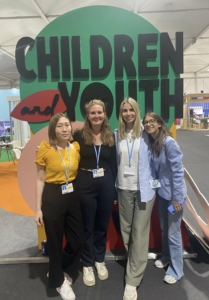 Nonetheless, there were many young people at COP that we were able to connect and coordinate with – a partnership building which resulted in a collective push for the phasing out of fossil fuels at the EU level. As our delegate Timea said: “I think young people did their best at this COP to make a powerful impact on progressing climate action. The Children and Youth Pavilion was always filled with an audience, having interesting events and influential speakers.” The value of young people’s contributions did not go unnoticed.
Nonetheless, there were many young people at COP that we were able to connect and coordinate with – a partnership building which resulted in a collective push for the phasing out of fossil fuels at the EU level. As our delegate Timea said: “I think young people did their best at this COP to make a powerful impact on progressing climate action. The Children and Youth Pavilion was always filled with an audience, having interesting events and influential speakers.” The value of young people’s contributions did not go unnoticed.
A step forward on Loss & Damage
The most positive outcome of COP was undoubtedly the announcement of a Loss and Damage fund, after years of advocacy from the Global South. Especially Small Island States and other countries particularly hit by climate change have been using COPs to highlight the need for measures to support efforts to adapt to this new reality and finance the costs caused by the climate crisis. This is sometimes understood as ‘climate reparation’. While the details of this fund, who will pay and what amount, are yet to be decided, it is a historic move which will reopen the conversation of responsibility surrounding climate change. Will it be based on historic emissions and responsibilities? A question of a country’s development status? The EU’s Frans Timmermans argues: “I think everybody should be brought into the system on the basis of where they are today… China is one of the biggest economies on the planet with a lot of financial strength. Why should they not be made co-responsible for funding loss and damage?” The current list of developing vs developed countries used in negotiations is based on a UN determination from the 1990s. We will have to watch and see how the Loss & Damage fund puts in question responsibility and who will end up contributing to the fund.
Given the focus of this COP on implementation, and therefore adaptation, this result can definitely be seen as a step forward. Yet there is more adaptation needed if we don’t keep acting on mitigation. This implementation plan did not include the phasing out of fossil fuels – an essential step for climate change mitigation. Keeping 1.5 °C alive has never felt more precarious.
Organising side-events
As civil society, one of our best opportunities was to organise and host side-events. In week 1, in partnership with the European Environmental Bureau and the International Foundation for African Children, we organised an Intergenerational Dialogue on Climate-Induced Migration in the framework of adaptation. We were able to bring together a diverse range of figures from H.E. Nduwa Mkaka, the Minister of Natural Resources and Climate Change of the Republic of Malawi, to Koko Warner the, Manager of the Impacts, Vulnerability, & Risks Sub Programme at UNFCCC, and Sinziana Puscas, a Climate Change and Migration Specialist from the International Organisation on Migration (IOM).
Overall, we were able to have a moment of exchange on what we believe to be an essential topic when considering implementation and adaptation. We were also able to host a UNFCCC-approved protest in the Blue Zone at the end of Week 1 – calling for the protection of environmental defenders and denouncing the fact that multiple countries view environmental defenders as criminals. Studies have found that between 2012 and 2022, more than 1700 environmental activists have been murdered or gone missing. This felt particularly pertinent in the political context of Egypt.
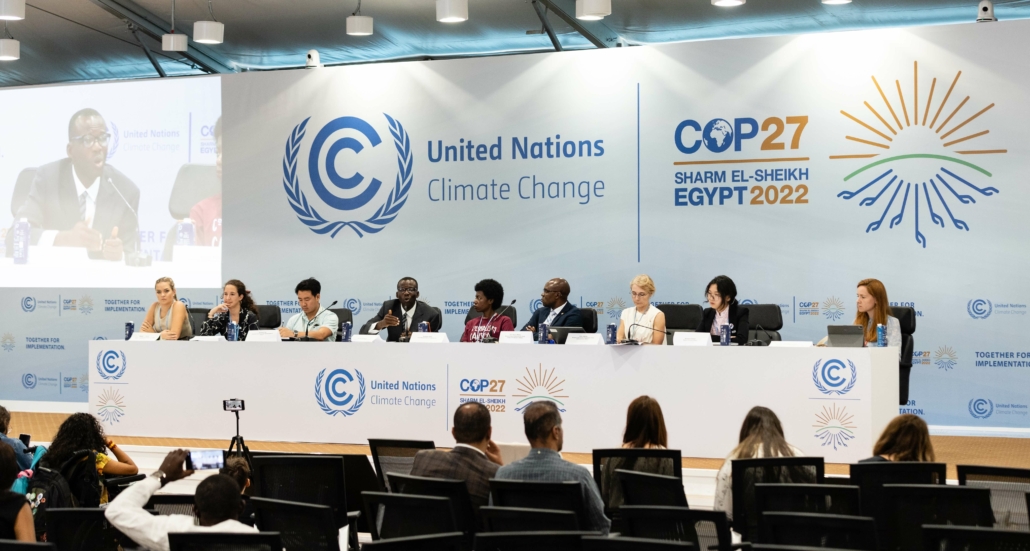
In the second week, we organised a networking session on intergenerational equity in the Youth & Children Pavilion where we shared our frustrations about youth involvement, or rather the lack of it, in the decision-making processes with Dr. Christina Voigt, the Chair of the IUCN World Commission on Environmental Law (WCEL), who was part of the negotiations as an academic. Dr. Voigt stated: “If you ask, what is intergenerational equity, my answer is, that is what is missing at COP.” Overall, these side-events were very meaningful to our experience at COP – a definite challenge but fruitful.
A challenging experience overall
There was no shortage of challenges at COP – from the pure stressful environment of thousands of people milling around hundreds of pavilions to the pressure felt at being a young person in such a professional and intimidating space.. A key hardship our delegates felt was the frustrations and disappointment at what was being said in negotiation spaces.
As Sophia recounted:
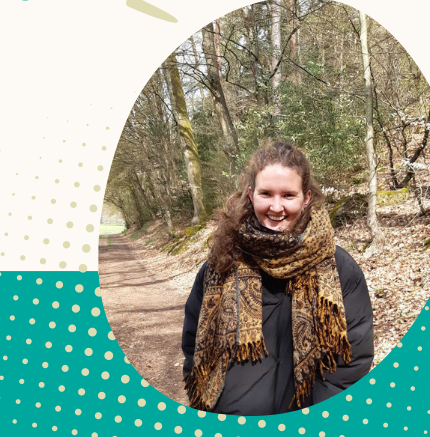
And this is when we were able to access these spaces: our observer badges did not guarantee full access. This resulted in a “lack of transparency of negotiations (which) further deepened our anxiety. Not only did we have no access to negotiations as Observers, but also there were no newsletters or other reliable sources to follow how the negotiations were going” said our delegate Timea.
The political context was also particular. Our head of delegation for week 1, Pegah, described how “everyday, our team was concerned about what to say and what not to say, so they do not put themselves or their team in danger”. Our Strategic Communications Officer, Chloé, agreed: “Mincing your words, when you are meant to be part of civil society, is counterintuitive.” We will be publishing more thoughts on this particular aspect of COP27 soon.
Finally, the very setting of COP27 in Sharm el-Sheikh caused “cognitive dissonance” as Chloé affirmed. Adéla described how

Two weeks for learning and inspiration
It’s easy to fall into feelings of stress and frustration at COP, all well-founded. It is a challenging environment for anyone – from a young climate activist to a seasoned diplomat. But it is clear that there are some positive aspects to these huge events that gather climate professionals and civil society from all four corners of the globe. Firstly, it’s a steep learning curve. Timea articulated this: “I learnt a lot, exchanging with youth coming from different regions and realities, as well as with experienced policy-makers and experts… It gave me a lot of motivation and hope to see young people working together, fully committed for a better future”.
“It is so uplifting to find yourself surrounded by people talking as passionately (or more passionately) about your interests day in and day out: a continuous reminder that I have so much to learn” agreed our Strategic Communications Officer, Chloé. Overall, it is about seizing the opportunity as Anna affirmed “COP can be a great source of inspiration for those who seek it.”
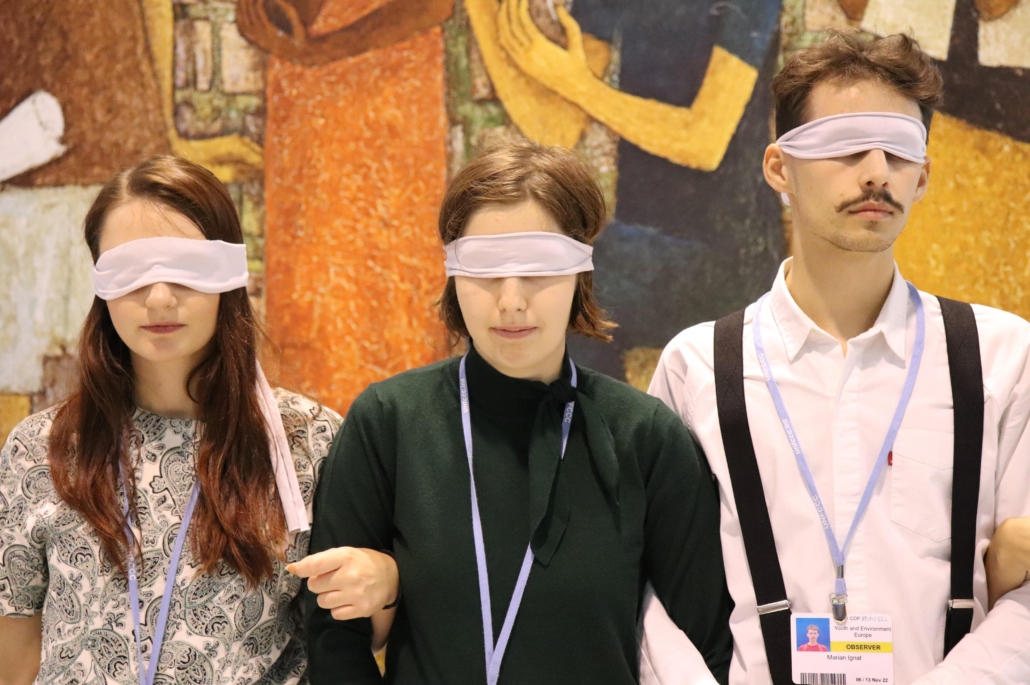
Hope was not eclipsed by despair – “Even in this desert of frustration, there are still islands of hope. I joined a loss and damage climate strike and had an opportunity to speak or even yell from the heart and I met many young climate activists who are so passionate and wholehearted, so I dare to hope that our future is in safe hands” stated our delegate Aleksandra.
Some of the outcomes inspired optimism, our head of delegation for Week2, Agnes, described how “after reading the final decision of COP27, I felt the spark of a small victory by the explicit mention of the role of youth in addressing climate change and the encouragement towards including youth representatives in the climate negotiations.”
Eva, our Communications Manager, attested that “after spending the week at the conference, hearing some great speeches, seeing some great work from experts, and observing many protests, I might hesitantly agree that it is actually our best shot at doing anything about the climate crisis on the global scale. By saying this, I am however not trying to excuse the greenwashing, the inaction, the obvious business interests, the propaganda of the organisers.”
Overall, there’s no easy way to summarise being a young person at such a high level event, as our delegate Marian said:
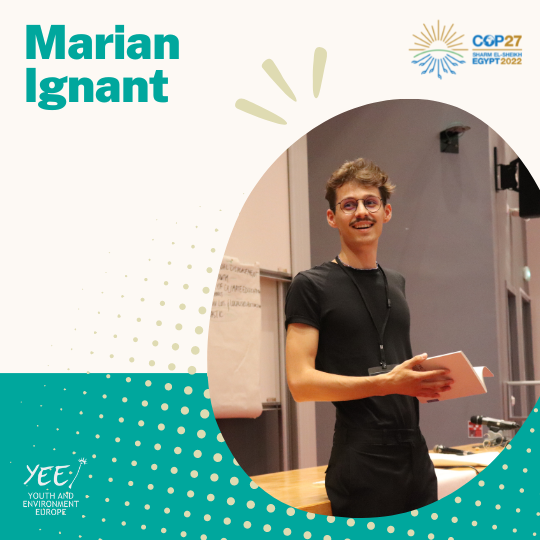
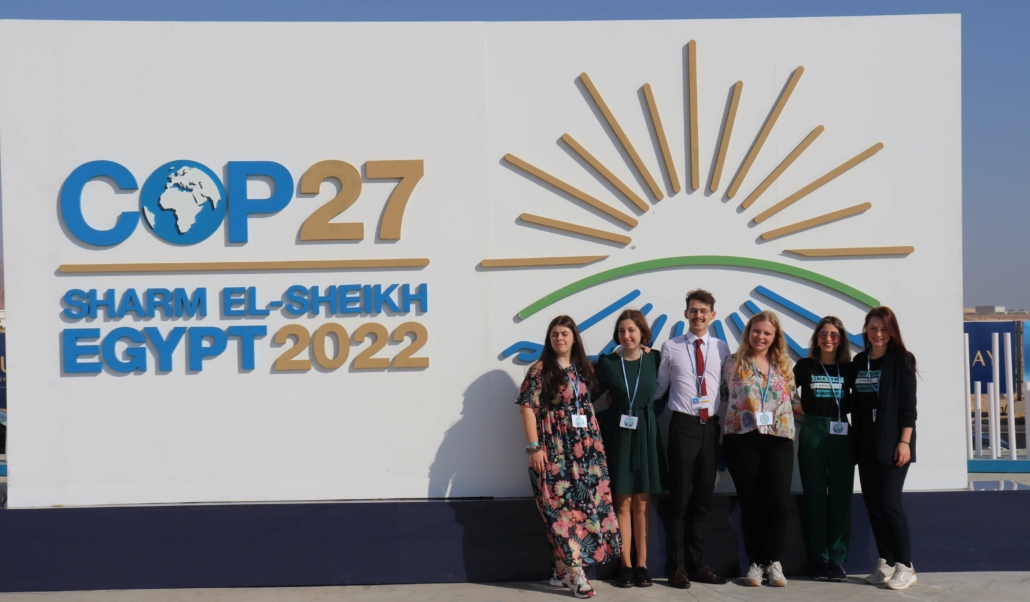
COP27: A breakthrough on climate damages, but still far to go – European Climate Foundation
A Tale of Sand and Power at COP27 – Ecosprinter, Federation of Young European Greens
BREAKING SILENCE ON CLIMATE AND SOCIAL INJUSTICE AT COP27 – Meta, European Environmental Bureau
Statement by President von der Leyen on the outcome of COP27
COP27: Key outcomes agreed at the UN climate talks in Sharm el-Sheikh – CarbonBrief
EU opens the door to a loss and damage facility – if China pays – Climate Change News
As you read the full reflections written by our delegates, please keep in mind that when some of us who attended just week 1 started to reflect on our experiences, the negotiators are meant to be wrapping up negotiations and preparing for the publication of final statements. Therefore tone or references made may not be up to date.
COP27 Reflections – Together for implementation?
https://yeenet.eu/wp-content/uploads/2022/12/Reflection-Post.png 540 540 YEE https://yeenet.eu/wp-content/uploads/2018/11/logo-yee-728x1030.png YEE2022-12-07 12:01:052023-03-31 15:02:05COP27 Reflections - Together for implementation?The Earth is burning, the COP is drowning
After a hot summer, you’d think the next COP would finally be the one for action, but the negotiations are stalling. We, the young observers of the international climate negotiations, reveal to you the hopeless backstage of this summit’s preparation. There is an urgent need to reform this institution, which remains fundamental in the fight against climate change. We propose the establishment of
a Global Citizens’ Climate Convention.
Written by Lou Collin and Thomas Reboul, this paper benefited from crucial contributions from Anna Antraygues.
Translated from the French original by Lou Collin.
After our first experience of international climate negotiations at the United Nations campus in Bonn, we came back with a bitter taste. While we had the honor of playing the role of young observers at the 56th session of the United Nations Framework Convention on Climate Change (UNFCCC) “implementation” negotiations, we also and above all had the regret of attending a bad play bringing together 198 countries known as “the Parties”. Large, sanitized rooms serve as the stage and the program is always the same. The (non)text machine is launched, fuelled by a ballet of verbal negotiations strictly codified by the UNFCCC to find agreements, present objectives and action plans that are, on paper, ever more audacious. As for their implementation, the Global Assessment scheduled for COP28 should shed light on the extent to which countries are lagging behind in meeting their targets.
In between ‘working’ sessions, a participant who started going to UNFCCC events at COP2 warned us: ‘I haven’t been to the negotiations for years and years. They will never lead to anything concrete. The most interesting thing to do here is outside the working rooms. This is the international climate fair, an invaluable place to find new allies and promising projects to try to mitigate the damage. Indeed, what happens in the negotiating rooms is disconcerting. The will of the nations, which can be measured by the speed and quality of the discussions, is inversely proportional to the climate emergency. Some delegations, often well-funded, from the so-called “developed” or fossil fuel exporting countries are meticulously sinking progress that could help them meet their 2015 Paris commitments. Meanwhile, the less wealthy countries and those most vulnerable to the consequences of climate change cannot follow all the negotiations: small teams due to poor resources, lack of trained negotiators, difficulties linked to master English, the technical UN language, etc. In addition, there are appalling visa problems that prevent delegations, observers and indigenous communities from arriving in time in the country of the negotiations. It is difficult to negotiate when you cannot travel to the country where the talks are taking place…
We also question the slowness of the UN process. Discussions very quickly move away from the substantive issues to argue about the progress of the negotiation, the format of the document, whether or not to display the text under NBC 1 discussion, the placement of punctuation, etc. All too often, therefore, we found ourselves faced with debates on the form of a text, emptied of its initial substance. Entire passages are discussed at length and then finally excluded if a consensus is not reached. Indeed, with the principle of unanimity that reigns in these negotiating forums, as soon as one Party opposes a term, the machine breaks down. Thus, on several occasions, the Parties only agree on the fact that they did not agree.
In rare working sessions, we have the right to speak. We have taken advantage of this to denounce the Parties’ desire to turn land, forests and oceans into economic assets. For example, during the first “dialogue” on oceans and climate change, which featured four hours of self-congratulatory statements by the Parties, one of the signatories of this forum called on the assembly to address issues that have been avoided until now: overfishing and deep-sea trawling. This appeal, as well as the one on the need to develop truly protected maritime areas, without industrial fishing, remained unanswered. Behind the scenes, a delegate from a country with significant fisheries resources, although silent during the dialogue, came to greet the intervention at the end of the session. On the other hand, the delegation from another European country revealed its unease at the non-existent position of the European Union on these issues.
In the end, we sensed a conformism, even apathy, on the part of some delegations in the face of our sometimes disturbing questions. The demands of countries suffering the consequences of climate change today are often ignored. Elements of language and rhetorical pirouettes sprinkled with economic justifications and technological solutions are all techniques that prevent substantive debates and allow the positions chosen by governments to be maintained. These discussions give the impression of a profound disconnection from reality and show the deleterious effects of the structure of international climate negotiations on ways of thinking about and responding to systemic problems.
These are our worrying observations. Unfortunately, the international community is currently relying in part on this mode of operation to reverse the curve of greenhouse gas emissions, the increase in the Earth’s average temperature, the decline in biodiversity, desertification, soil and water pollution, the destruction of primary forests, the frequency and intensity of extreme weather events, rising sea levels, etc. It is therefore urgent to rethink the environmental negotiations, which are vital for facing the climate crisis together. Young people and most NGOs are the only ones who can express themselves freely in these international debates. In Bonn, negotiators encouraged us to act, even though they are the ones at the negotiating table. In response to this invitation, the No Bullshit Coalition (NBC) has formed to sign this platform.
In addition to calling on the Parties to respect their promises of action and financing, here is our innovative recommendation to transform the functioning of the UNFCCC and, why not, try to save the COPs from drowning.
We propose the establishment of a new body within the UNFCCC processes, one that is decision-making, inclusive and citizen-based: the Global Citizens’ Climate Convention. Based on the principles of the French Citizens’ Climate Convention, it would bring together the world’s citizens in a representative and inclusive manner, for example with regard to indigenous representatives or NBC 2 The Non-Bullshit-Coalition is calling for ideas and recommendations from citizens to make this proposal a reality in order to save the COPs from sinking and to spare as many people and ecosystems as possible from the effects of climate change. If you have ideas on how to make this idea more concrete, debate with #NBC. Because the political and ruling class has given up on international climate negotiations, it’s time for citizens to take matters into their own hands.
The following organisations support it: ● Youth Environment Europe ● Avenir Climatique ● NOISE – Office of Governance and Inter-school Coordination ● NOISE – bureau de gouvernance et de coordination interécoles ● NOISE – AgroParisTech ● NOISE – ESSEC ● NOISE – ESCP ● Esp’r – HEC ● Les Agros à la COP – Agro ParisTech ● Dévelop’Ponts – Ponts ParisTech ● PC Durable – ESPCI ● Terre à Terre – ENS Saclay ● ENvertS – ENS de Lyon ● Make a difference (MAD) – Télécom Paris ● Écosyst’aime – ENSTA ● SupAero for Earth – SupAe ● Esp’r – Supoptique ● Eole – ESTP NBC ● Greensae – ENSAE ● Les ENSGagés – ENSG ● Assas Environnement NBC
The Earth is burning, the COP is drowning | Opinion article
https://yeenet.eu/wp-content/uploads/2022/11/The-Earth-is-burning1.png 540 540 YEE https://yeenet.eu/wp-content/uploads/2018/11/logo-yee-728x1030.png YEE2022-11-07 16:38:522023-06-23 09:18:58The Earth is burning, the COP is drowning | Opinion articleOur mission
 YEE aims to unite environmental youth non-profit organisations in Europe in order to enhance international cooperation, increase knowledge about the climate crisis, raise awareness of environmental problems and to strengthen participation of youth in environmental decision-making.
YEE aims to unite environmental youth non-profit organisations in Europe in order to enhance international cooperation, increase knowledge about the climate crisis, raise awareness of environmental problems and to strengthen participation of youth in environmental decision-making.
Get in touch
Vinohradská 2165/48
120 00 Praha 2 – Vinohrady
Czech Republic
E-mail: yee@yeenet.eu


Financially supported by the European Youth Foundation of the Council of Europe. The views expressed do not necessarily reflect the official position of the Council of Europe










